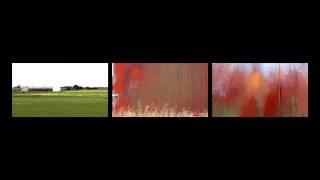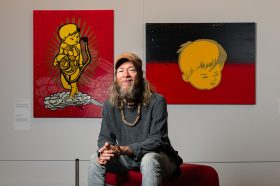Recently I was among a group of people gathered in Jaara Country, the land of the members and Elders of the Jaara people of the Dja Dja Wurrung community, to open an exhibition by Ash Keating, The West Park Proposition, at the Latrobe University Visual Arts Centre in Bendigo.
Ash is one of Australia’s significant artists. I described his work as impactful, influential and important. I used this language deliberately, not just to make Ash feel uncomfortable and his Gran proud, but to give each of us a new sense, a heightened sensitivity as we stepped into that darkened space. The sense that something important is happening here.
On an immediate level, the most important thing is the feeling of joy that the work conveys: lightness, spontaneity, movement, confidence, speed, agility.
Art is vital to our lives. It gives us the limits of our horizons, and then blasts those limits away. It challenges our minds to bring things together – shapes, colours, lines, materials, lunges and splatters, history and culture, fabrication and waste – and then, in the ways they’ve come together, to form new forms, new ideas, new analyses and interpretations.
At the same time, right now we’re working our limits as a community and as a people in another kind of way. We’re pushing the city limits, pushing the environmental limits. We’re allowing this, every day, and it just keeps happening. This is the extent of our planning strategy right now. Ash’s work consciously addresses this edge condition, this moving out into who knows where.
We’re at the point of luxury now. We can stop and reflect on what we’ve done, on what we’re doing… but for how long? The tipping points are past. The fringes of urban and regional cities have been extended, lost.
I was reminded of another artist, Michelle Hamer, also working at the edge condition, but on the smaller small scale of duration: the moment, the pixel. Michelle photographs the sites of the urban fringe, and then creates embroidery works from those images, taking the time to hand-stitch every detail. By the time she has pixellated each moment by hand, the moment has passed; the development has been made; the embroidered work is an image of something that no longer exists.
Unlike Michelle’s deliberately considered small scale, Ash gives us grand scale for perceiving the impacts that we’re having through every small decision, through each unreflected shift outward, through each splash of the brush. It’s already too late. And yet, we’re here.
His first multi-channel work, presented with the unique capacities of the Latrobe University Visual Arts Centre space, involves two works speaking to one another: two separate works, the smaller an accompaniment for the larger. Ash describes the work Painting the West Park Proposition 2013 as a documentary, a retreat, a didactic panel, and importantly, as a work in its own right. What it documents is not only the process of the creation of the work, but the process of the development of its techniques. We see Ash finding ways to use the weight of the bucket as its paint is thrown against the wall, or work the nozzles of his modified fire extinguishers. We see his shoulders open up, his gaze find new focus.
The walls of the gallery space are mid-grey to emulate the concrete of the work, making the dazzling colour jump out the way it did for Ash on that tilt-slab wall, against the darkening sky, creating a startling contrast for this large-scale composition.
For me, composition is what’s most vital to Ash’s work. Art creates new compositions, new intersections, new public places to express and experience our condition. Composition in Ash’s work is about confidence, audacity in scale, and then a reflection back on a higher synthesis.
Ash’s 2020? (2008) at Arts House Meat Market as part of the Next Wave Festival, which many of us have seen, was a compositional work of substantial scale created by intercepting unused materials intended for landfill. It was a work that dwarfed you as you walked around it, and yet here was your footprint on the environment. The collaborative, process-based work involved careful audit and analysis of those waste materials, while the work with which people interacted was a massive cumulative composition, growing by the day.
There’s another of Ash’s collaborative works that I wanted to evoked, and that’s the dance piece 24 Hours (2010), performed at Dancehouse and choreographed by Nat Cursio. Each choreographer had just 24 intensive hours to develop the performance which involved three performers and a visual artist, Ash Keating.
Within that context, rules and set-piece situations prevailed over deliberate and rehearsed choreography given the time constraints, resulting in a piece which was composed and then decomposed, constructed and then deconstructed. The composition here – materials on the way to the tip, many or most entirely unused – was designed to scatter into the space in response to the movement of bodies, the playing out of the game. To compose something that is not yet meaningful, out of objects whose value has been rendered worthless by society, and then watch as new compositions were made by the dancers – this was an extraordinary experience and an important reframing of our relationship to the materials that purport to shape our lives.
I’ve had the pleasure of collaborating with Ash on one unrealised project, as well as one group project for the ADC Cities Summit called Surprise City, where our role was to be troublemakers.
The slogan that emerged from our work, Plan Unintended Consequences, itself offers a way of seeing Ash’s work: opening a space, working its possibilities with confidence, at a scale greater than all of us, and without deliberating on the work as a designed outcome. Ash might be “the small figure against the grandiose wall” to use his own words, but he works a space and he works at a scale that’s truly remarkable.
Ash composes new work through processes that are artworks in themselves, and that’s what’s captured here. What isn’t captured – or what I hope is captured – is his audacity, his fearless confidence as a maker that he can plan unintended consequences and sense that those consequences will compose themselves into something vital and resonating – and beautiful.
Ash has recently won the $20,000 Guirguis New Art Prize, and I commend the generosity of philanthropist Mark Guirguis for inaugurating the richest art prize in Ballarat. The $10,000 Substation Contemporary Art Prize, which Ash won for another work, A New Lifelong Landscape (2011), is supported by Metro and Hobsons Bay City Council, and I commend their vision for Melbourne’s west under the leadership of Substation director, Jeremy Gaden.
Ash Keating’s The West Park Proposition
Latrobe University Visual Arts Centre, Bendigo
Thursday, 20 June to Sunday, 28 July





